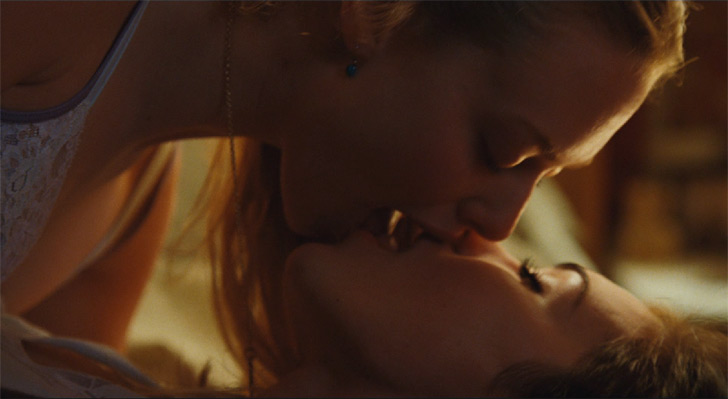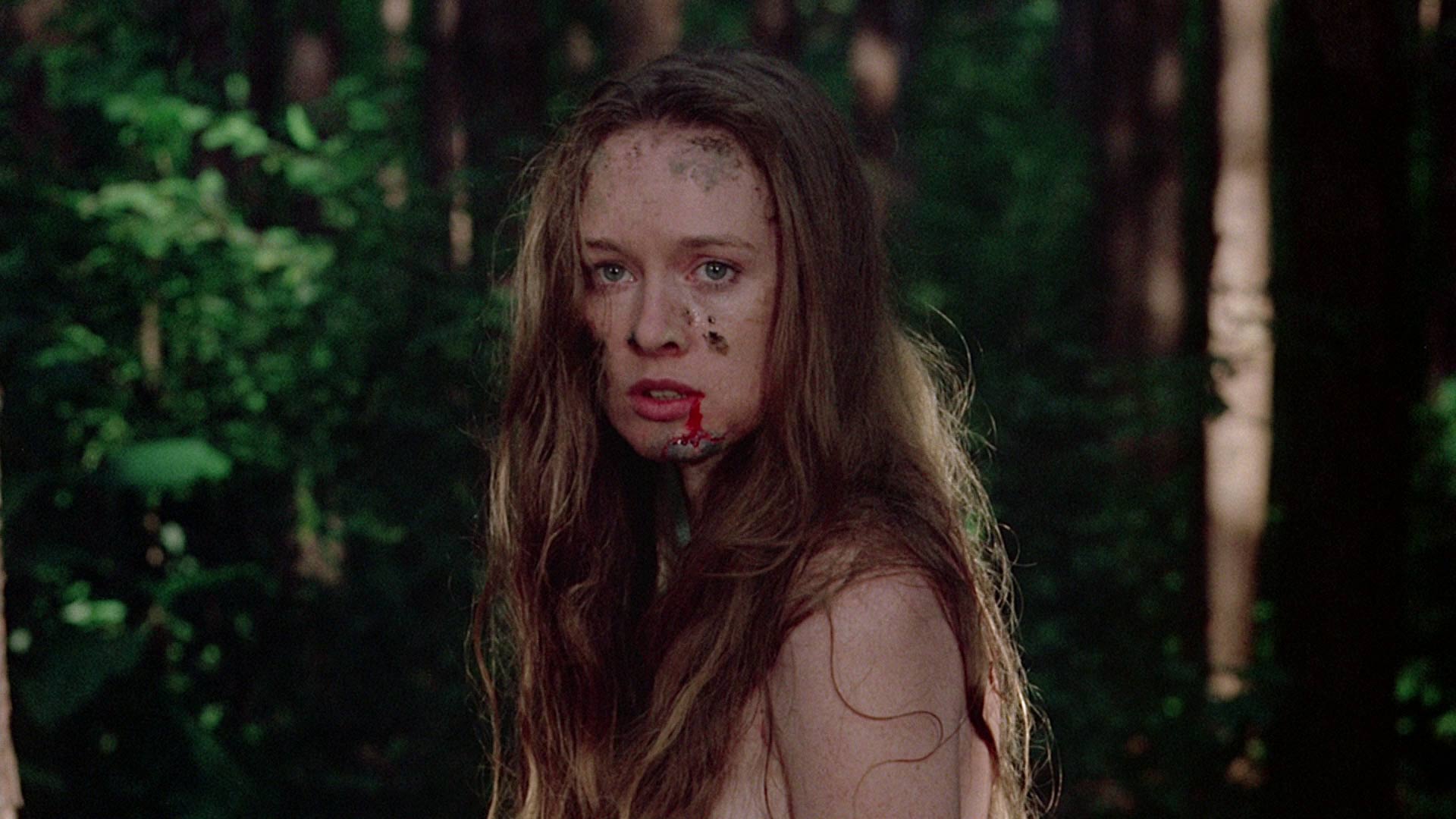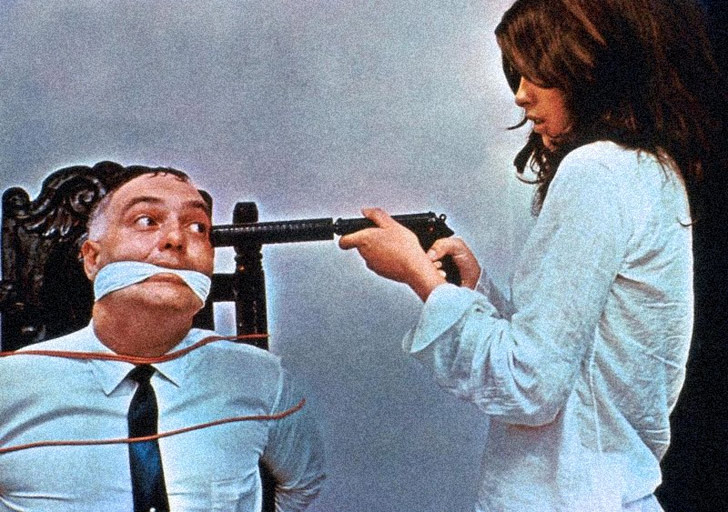
Jennifer's Body
Evil-but-gullible emo band's attempted "virgin sacrifice" turns promiscuous teenager into demon-possessed cannibal. It's up to her nerdy best friend to keep the sexiest high-schooler in Devil's Kettle from eating her way through senior class.
That's a fairly straightforward synopsis of Jennifer's Body, screenwriter Diablo Cody's much-hyped follow-up to Juno, directed by Karyn Kusama and just out on DVD and Blu-ray Disc. It sounds like a terrific idea for a comic horror movie, turning adolescent sexual insecurity into the stuff of nightmares, and it is pretty smart conceptually. Cast as the titular Jennifer, a sarcastic, wisecracking bombshell of a flag girl, Megan Fox acquits herself beyond the Maxim-girl status bestowed on her by the Transformers movies, turning in a fairly competent performance that progresses credibly from her character's more human presence in the film's opening scenes to the colder succubus she becomes. And Amanda Seyfried, all gasps and big eyes, makes a terrific mostly passive protagonist for the yarn, taking Jennifer's transformation in from a not-so-safe distance.
Get Jennifer's Body on Blu-ray pr DVD from Amazon.comCody's scabrous sense of humor is on full display here, starting with the arrival at a local dive bar of Low Shoulder, a band whose leader is a smug cretin but also a lust object for Jennifer. She's dragged her BFF Anita, whose overdetermined nickname is "Needy," to the show, where she puts on a sweet-young-thing act, introducing herself coquettishly to the leering singer. As the band plays, the bar erupts in a mysterious fire, killing many concertgoers. Jennifer and Needy escape the flames together, but separate soon after -- Jennifer flees the scene with the band, riding away in Low Shoulder's touring van as Needy calls after her helplessly.
The irony, of course, becomes apparent. Needy fears that the always-forward Jennifer will be taken into the woods and, essentially, gang-raped by enthusiastic sex-predator rock-and-rollers. Instead, she's empowered. It turns out the saps in Low Shoulder bought her unspoiled-maiden schtick, driving her out of town for the express purpose of ritual virgin sacrifice. As the film's mythology goes, because Jennifer fit no dictionary definition of virgin, the demon instead took up residence in her body — a body that would give any otherworldly intruder bent on mayhem a certain psychological leverage over potential victims. When Jennifer arrives back at Needy's house, covered in blood and sweat and grime, Needy figures she's been assaulted. In reality, she's been feeding.
It's grim stuff, with disquieting overtones. The subject matter now encompasses chauvinism, male privilege, and threatened (and perceived) sexual violence along with its lighter themes about the wedges that can be driven between best friends by high-school social structures, impending young adulthood, and the attendant encroachment of sexual longings. Jennifer spends the film working her way through teen-movie stereotypes, disemboweling first the jock and then the goth kid, and finally setting her sights on Needy's own boy, the baby-faced Chip (Johnny Simmons). A showdown ensues as Needy comes, violently, of age.
Jennifer's Body is full of ideas, but it doesn't have much in the way of tonal control. The script is written more or less as black comedy, with Cody's wisecracks pretty much taking the potential sting and/or suspense out of any given scene and moving character interactions into the realm of abstraction. Her sense of wordplay owes a clear debt to Heathers, but without that film’s satirical feel for the absurd. Still, there’s a nastiness right under the surface. In the film’s nightclub scene, Cody baits viewers with gratuitous references to two different early-2000s tragedies — the fire at a Rhode Island Great White concert that killed 100 people, and the 9/11 attacks, which are spoofed with a pair of commemorative red-white-and-blue cocktails stacked in shot glasses. I’m not that guy in the back of the theater yelling “too soon!”, but it’s enough to snap you out of the movie and wonder what was really on Cody’s mind? Is she mocking the midwestern locals and their “United We Stand” sentiments? Or is she just trying, clumsily, to conjure up a sense of dread and despair through spooky points of reference?
I wish the film was less eager to follow its impulses to jokiness. A scene early in the film is set inside a mental asylum, where Needy has been committed after as-yet-unexplained events that take place in the film's final act. She explains, in amusingly wry dialogue, that she's known to the orderlies and nurses as "a kicker," which is a pretty funny line on its own. Kusama dramatizes this not just by having Needy ferociously kick the shit out of someone on screen -- which might have been a pretty great moment on her own -- but by having her kick the shit out of someone on screen who then goes flying through the air like she was just schooled by Tony Jaa. Clearly Kusama (and Cody, if the script was written that way) decided against nurturing the atmosphere of a horror movie, opting instead to dive into pure comic-book territory.
Granted, Megan Fox is already something of a comic-book character -- and I don't say that as a dis. She's got attitude to spare, and she's built like one of those impossibly slender Mary Jane Watson figures from early Todd McFarlane issues of The Amazing Spider-Man. I'm not sold on her as any kind of major talent, but she is genuinely fun to watch on screen. She's sensually aggressive to boot, and that's exactly what this movie calls for. But Jennifer is so sexually confident, and seems to represent so many things that Needy objects to, the film is never quite able to explain exactly why she and Needy have remained close all these years, beyond some murmurings about "sandbox friends" that represent an early childhood history together that’s eventually repudiated.
A lingering love scene involving full-on kissing between on-screen girlfriends is meant to depict a turning point in the relationship, as finally, through seduction techniques, Jennifer threatens to become hazardous to Needy’s health. But it’s hard to care about the corruption and dissolution of a relationship that is never really seen to cohere in the first place — and because the film is never scary in the slightest — the moment plays purely as an adroit display of teen-movie showmanship. At least minor multiplex-trash classics like Cruel Intentions and Wild Things were cynically self-aware about the nature of their glossy girl-on-girl action. In their audio commentary track, Kusama and Cody declare that they’re shocked — shocked! — that anyone would read the scene as titillation for titillation’s sake. It’s all about the characters, natch, and the intensity of their feelings. At any rate, this kind of thing could be scene-of-the-year material in a tenser, more committed horror film, but it’s not especially stirring here.
Finally, I’m a little baffled by reviewers who toss off references to the film’s “feminism.” I mean, I do wish it were true. But on what planet is a film about a straight-up succubus — that centuries-old, malevolent manifestation of female sexuality — somehow feminist? Is it the narrative inversion of the vaguely porno title that’s supposed to do it? Tweaking conventions is not the same as subverting them.
At least Fox and Seyfried both look great throughout, and cinematographer David Mullen — with the help of what looks like some reasonably aggressive DI color timing — lends the film a music-video sheen, combining deep blacks and a high-contrast look that keeps lots of points of detail visible even down in the shadows. The story never works up a head of steam, but Kusama and Mullen take the film into a fairly impressive visual mode for the final set piece, which takes place in and around an indoor swimming pool that’s surrounded by vines snaking down the walls and into the water. When a determined Needy shows up, her own fragile body nearly overwhelmed by a big pink prom dress, to do final battle, it’s a surprisingly fitting treatment of material that still never manages to find its own style.
Blu-ray Notes
Give 20th Century Fox Home Entertainment credit — the film was considered a box-office underperformer, but its Blu-ray Disc release of Jennifer’s Body is a nice package. If this is destined to become a cult movie, the cultists will have a lot to explore here. The picture, barely letterboxed to 1.85:1, has a soft, film-like look in HD with a consistent degree of realistic-looking film grain visible. If noise has been dialed back, it’s been done tastefully and may well have happened in the DI process. (Theatrical release prints aren’t nearly as grainy as they used to be for a variety of reasons, including the increasing use of digital tools for image manipulation.) But the picture is very pretty even on a frame-by-frame basis, with intently beautiful colors emerging from the darkness. If anything, I’d complain that most scenes are way too clean and well-lit for anything resembling a horror film! And the surround mix is amply represented with a 5.1 DTS HD MA track (English only; sorry rest of the world — you’re stuck with Dolby Digital).
The best special feature is the inclusion of the “unrated version,” which Kusama does refer to in audio commentary as a “director’s cut,” meaning it has the directorial stamp of approval, unlike some extended re-edits that take the “director’s cut” appellation even though they’re not the director’s preferred version. What’s more, the disc’s producers have gone to some length to make sure it’s easy for a viewer to tell the difference between the two versions of the film, which amounts to just over five minutes of footage. When you watch the unrated version with commentary enabled, a little film-slate icon pops up in the bottom right-hand corner of the image for the moments when Kusama actually discusses what was changed between versions. (The bulk of this track, which features Kusama speaking solo, is silent.) I simply scanned through this cut of the film at 10x speed on my PS3 and hopped back into the movie whenever I saw the icon appear. It’s a nice feature, and Kusama’s explanations of what was cut and why are quite generous.
The director’s cut itself is a bit of a mixed bag. Some bits, like the film’s restructured opening scenes, are much improved in this version. But other scenes really deserved to be edited, like the one depicting the mother of one of Jennifer’s victims lecturing two of the classmates who come to his funeral on the nature of her grief. The poor kids, done up in full goth gear, are depicted as pathetic, self-centered clowns — it’s just mean. (There’s an even longer, more excruciating version of this in the deleted scenes section.) On balance, the director’s cut is likely the superior version of the film, but what makes it valuable is the insight Kusama provides into the editing process, talking not only about what changes were made, but how she feels they helped and hindered the film. (Some of them do both at the same time.) Students of editorial tactics will dig it.
The Kusama/Cody commentary track runs the length of the theatrical-release version, and it’s pretty standard mutual-admiration-society stuff. (“I like this scene!” “I like this line of dialogue!” “I like the way this actress delivers that line of dialogue!” “Congratulations Karyn!” “Congratulations, Diablo!”)
The disc includes just under 14 minutes of deleted scenes in HD (no commentary, no subs, stereo sound) that run the gamut from not so bad to pretty terrible. Worst of the bunch is the aforementioned extended version of the funeral scene with its garish goth caricatures. Best is probably the shower-room scene that extends Kusama’s running Brian De Palma homage with a fairly explicit reference to Carrie, complete with steamy nude girls. (Neither of them are the stars, so don’t get your hopes up.) Needy is trying to convince Jennifer that she could possibly reverse the curse that’s been placed on her. “You’re killing people!” she cries. “No,” Jennifer reasons, “I’m killing boys.” How do you cut that from your movie?
“Jennifer’s Body: The Dead Pool” is a surprisingly engaging 14-minute short in HD dealing mostly with the film’s final pool sequence. It includes lots of B-roll from the shoot along with truly cool nuggets, like VFX supervisor Eric Nordby explaining how a cool green-screen mouth was affixed to the face of Fox’s double for her big, demonic cannibal-vampire glamour shots near the end of the movie. That live-action plate was combined with other filmed and CG elements to create mostly seamless effects shots. There’s some other flotsam scattered around the disc, including eminently skippable “video diaries” (also in HD) and some Megan Fox-related material, but the half-hour program repurposed from Fox Movie Channel (SD only, alas) featuring film students asking questions of Diablo Cody about her career and creative choices is the only other meaty feature on the disc. A DVD with an unlockable “digital copy” is also included, for those who swing that way.
Apparently most of these extra features are exclusive to Blu-ray. The DVD includes both versions of the film (along with both commentary tracks) without the copious added attractions. That means the DVD will get you through the comparison of theatrical and director’s cuts, if that’s mainly what you’re interested in. But for fans of the film who will be interested not just in much-improved picture quality but also in deleted scenes and behind-the-scenes material, the Blu-ray Disc is the way to go. The special features aren’t exactly comprehensive, and the film ain’t Criterion Collection material. But, as studio-released special editions go, it’s solid.
Get Jennifer's Body on Blu-ray pr DVD from Amazon.com


